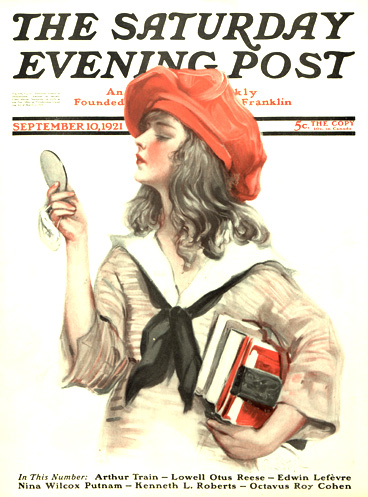We’ve chosen Post covers between 1909 and 1960 showing the American teenager as depicted by Norman Rockwell, Stevan Dohanos, John Falter, and other great illustrators.
Woman with Basketball
Woman with Basketball
Carol Aus
November 20, 1909
Very little is known today about Norwegian-born illustrator Carol Aus (1878-1934) except that she was known for portrait painting. That talent shines through in this 1909 basketball player.
The Post published seven of Aus’ portraits, all of which appeared on the cover.
Schoolgirl Primping
Schoolgirl Primping
Paul Stahr
September 10, 1921
This pretty cover girl, whose only concern is looking good in a new hat, was created the same year Albert Einstein was lecturing about his new theory of relativity in Stahr’s home state, New York. As a longtime resident of Long Island, Stahr (1883-1953) was close to the East Coast’s publishing companies, and he took full advantage of it. He illustrated for Life and Colliers and was versatile enough to become known as a pulp magazine artist.
The pulps were inexpensive fiction magazines popular from the 1890s through the 1950s (they were printed on cheap paper from wood pulp, hence the name). From 1924 to 1934, Stahr created a number of covers for Argosy magazine, a pulp that boasted authors such as Upton Sinclair and Zane Grey.
Movie Star
Movie Star
Norman Rockwell
February 19, 1938
The Saturday Evening Post had reached its 3-million-circulation milestone just before this cover was published. Rockwell liked to have fun with the familiar logo, and in this case, he obscured part of it with dormitory regulations. The rules state that male companions are not allowed in the dorm at any time, but with a stash of movie-star photos, these teenagers have found a loophole. The idol in hand is actor Robert Taylor, who made millions of female hearts beat faster in his starring role opposite Greta Garbo in Camille. Movie magazines were just then becoming a national pastime—at least among teenage girls, who were trading and swooning over glossy photos of the current heartthrobs.
Rockwell created several covers that included pictures within a picture. Another example of this is The Great Debate, where the newspapers in the illustration clearly show 1948 presidential candidates Truman and Dewey.
March Band at Football Game
March Band at Football Game
Stevan Dohanos
October 19, 1946
Playing an energetic march while keeping a close eye on the game requires dexterity only a teenager can manage, but Stevan Dohanos made sure the rest of us could watch the game in the tuba’s reflection.
Dohanos began this 1946 painting by filling his Westport, Connecticut, home with equipment borrowed from a local high school band. “The tough job,” he said, “was keeping my guests away from the instruments.” Post editors reported “almost everyone who dropped in while Dohanos was at work turned out to be a former musician, the kind who hasn’t laid lip to a trombone for 10 years, but is sure he hasn’t lost the old knack or wants to see if he can still play the second-coronet part from ‘Under the Double Eagle.’”
Fortunately for Post readers, Dohanos did get the job done, and he learned a lesson about his visitors in the process: “I never knew my friends had so much musical talent, or lacked so much.”
Father’s Homework
Father’s Homework
John Falter
May 7, 1960
Of this 1960 cover Post editors asked the question, “If one furrow-browed father spends x hours failing to solve the quadratic equations of one boy, how long would it take two furrow-browed fathers to fail to solve the quadratic equation of two boys?”
Though artist John Falter (1910-1982), a self-proclaimed “dunce in algebra,” may have struggled to find a solution for x, he never struggled to find work as an artist.
He was described by the Post as a workhorse sketching six days a week from 3:00 a.m. to 5:30 p.m. When he entered the Navy during World War II, he found a way to continue his career: he designed more than 300 posters and other recruitment materials for the military. The same year he enlisted, he created his first of 125 covers for the Post.That prodigious output continued throughout his life; it is estimated that he completed more than 5,000 paintings.
Become a Saturday Evening Post member and enjoy unlimited access. Subscribe now








